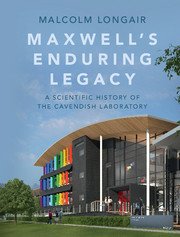Book contents
- Frontmatter
- Dedication
- Contents
- Preface
- Acknowledgements
- Part I To 1874
- Part II 1874 to 1879
- Part III 1879 to 1884
- Part IV 1884 to 1919
- 5 The challenges facing J.J. Thomson
- 6 The Thomson era, 1884–1900: the electron
- 7 The Thomson era, 1900–1919: atomic structure
- Part V 1919 to 1937
- Part VI 1938 to 1953
- Part VII 1953 to 1971
- Part VIII 1971 to 1982
- Part IX 1984 to 1995
- Part X 1995 to present
- Appendix The evolution of the New Museums site
- Notes
- References
- Author index
- Subject index
5 - The challenges facing J.J. Thomson
from Part IV - 1884 to 1919
Published online by Cambridge University Press: 05 July 2016
- Frontmatter
- Dedication
- Contents
- Preface
- Acknowledgements
- Part I To 1874
- Part II 1874 to 1879
- Part III 1879 to 1884
- Part IV 1884 to 1919
- 5 The challenges facing J.J. Thomson
- 6 The Thomson era, 1884–1900: the electron
- 7 The Thomson era, 1900–1919: atomic structure
- Part V 1919 to 1937
- Part VI 1938 to 1953
- Part VII 1953 to 1971
- Part VIII 1971 to 1982
- Part IX 1984 to 1995
- Part X 1995 to present
- Appendix The evolution of the New Museums site
- Notes
- References
- Author index
- Subject index
Summary
Thomson's election to the Cavendish Chair
William Thomson could still not be enticed back to Cambridge from Glasgow, despite a memorial, spearheaded by J.J. Thomson and sent to him with the signatures of a number of distinguished Cambridge scientists, urging him to stand. The Cavendish Chair was duly advertised and for the first time there was a competitive election. There were five candidates – Richard Glazebrook, Joseph Larmor, Osborne Reynolds, Arthur Schuster and Joseph John (J.J.) Thomson. Larmor was now Professor of Natural Philosophy at Queen'sCollege, Galway, while Reynolds and Schuster both held professorships, in Engineering and Applied Mathematics respectively, at Owens College, Manchester. Somewhat to his own and the University's surprise, the electors offered the chair to the 28-year old Thomson. Glazebrook was Rayleigh's choice, but Davis and Falconer (1997) argue that he was too wedded to the programme of the precise establishment of physical standards to appeal to the electors. Reynolds was thought to be more an engineer than an experimental physicist. The electors took a bold gamble on Thomson, but he undoubtedly had the potential to become a distinguished physicist.
Thomson had entered Owens College, Manchester at the age of 14 and was fortunate to be instructed by inspiring scientists – Thomas Barker lectured on mathematics, Balfour Stewart on natural philosophy and Osborne Reynolds on engineering physics. According to Arthur Schuster, Stewart made extensive use of argument by analogy, very much in the Maxwell tradition, and Reynolds, the pioneer of turbulent flow in fluid dynamics, lectured on the role of vortices in fluid motion. In Thomson's final years at Owens College, Schuster lectured on Maxwell's Treatise on Electricity and Magnetism and Poynting, who was to become a lifelong friend, was developing his insights into the interpretation of Maxwell'sequations. This training stood him in good stead when he was successful at his second attempt in obtaining funding in the form of an exhibition to Trinity College; in 1876 he matriculated studying for the Mathematical Tripos. Thomson was coached by Edward Routh and in 1880 he graduated second wrangler behind Joseph Larmor and joint first Smith'sPrize winner.
- Type
- Chapter
- Information
- Maxwell's Enduring LegacyA Scientific History of the Cavendish Laboratory, pp. 97 - 110Publisher: Cambridge University PressPrint publication year: 2016



